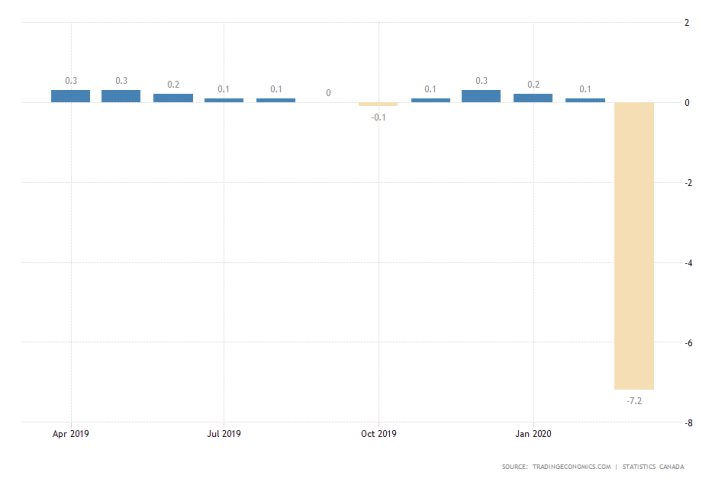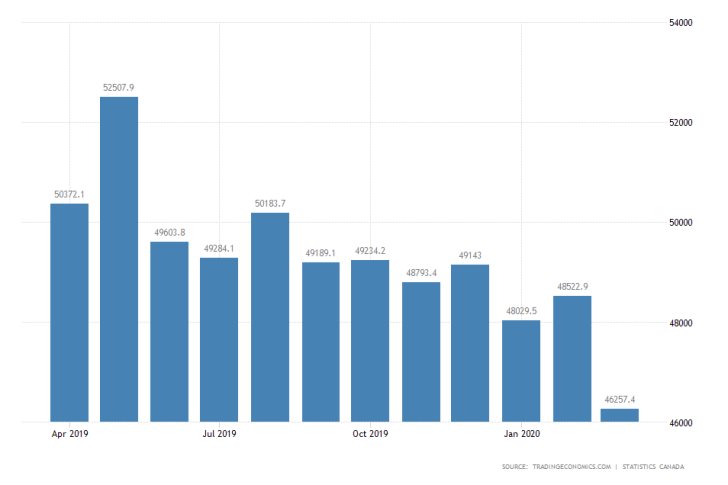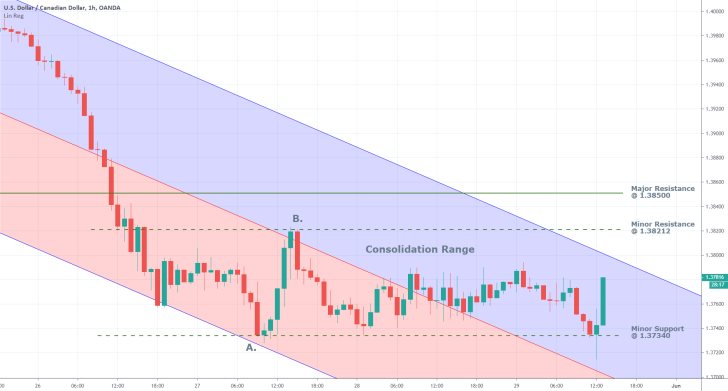
Statistics Canada just released its economic report on the recorded growth rate of the Gross Domestic Product for March.
The report revealed that the economy had contracted by a substantial 7.2 per cent in the wake of the coronavirus crisis. The findings of Statistics Canara demonstrated the largest monthly decline on record. However, the final results fell below the consensus forecasts, which projected a 9.0 per cent decline.

Similarly to the preliminary GDP data for Q1 that was released in the US yesterday, the Canadian economy has evidently suffered tremendously from the coronavirus fallout.
In addition to the economic strain from the pandemic and the government's decision to impose a national lockdown during the early days of the healthcare crisis, the Canadian GDP has also been hit from the woes of the energy market that were observed in early March.
The collapse of the oil prices in March delivered a devastating blow to the Canadian balance of trade, as the country is one of the biggest producers and exporters of the precious commodity in the world.

Nevertheless, the energy market has managed to stabilise after the initial turmoil, and the rising oil prices are going to affect the jolted value of the Canadian dollar positively.
Meanwhile, the Loonie depreciated against the greenback following the release of today's data, which was prompted by the substantial size of the observed economic contraction.
As can be seen on the hourly chart below, the price action of the USDCAD rebounded from the lower boundary of the underlying consolidation range, which is represented by the minor support level at 1.37340.
This could be the beginning of a bullish correction in an otherwise prevailingly bearish market, which is inlined with our projections from earlier today.
In remains to be seen whether the bullish correction is going to be substantial enough to break out above the minor consolidation range and the major resistance level at 1.38500, or the market would resume establishing the new bearish trend.
Overall, today's GDP data in Canada is bad news for the value of the Loonie; however, it was mostly expected by the market. Hence, the market has had time to price in the poor performance, which means that the bullish correction is unlikely to be extended for too long.
In other words, the poor GDP numbers probably would not be substantial enough to prompt the development of a new bullish trend on the USDCAD.
Moreover, the fact that the size of the observed economic contraction is nearly 2 per cent smaller than initially anticipated would probably result in an even faster conclusion of the current bullish correction's establishment.

Trendsharks Premium
Gold is undergoing a correction, as investors take profits to offset losses from falling stock prices, impacting their margins. However, we anticipate a renewed wave of [...]
The Swiss stock market index is mirroring its global counterparts, such as Germany 40 and US100, experiencing a sharp decline following the announcement of new [...]
We’re analyzing the weekly chart to grasp the broader market trend. Over the past three years, the US30 index has surged by 17,000 points, often resembling a nearly straight [...]
Over the past week, the DAX has experienced a sharp decline, plunging by an astonishing 3,400 points. This downward movement is not isolated, as its international counterparts, such as the UK100 and US100, are also facing significant [...]
EURUSD recently formed a double top at 1.0930, signaling a potential trend reversal, and has since begun a correction. After a 600-pip rally since early March, a pullback at this stage is both expected and healthy. Given these conditions, we are placing a [...]
Since early March, EURJPY has surged nearly 1,000 pips, providing us with several excellent trading opportunities. However, as the rally matures, many early buyers are beginning to take profits, leading to a noticeable slowdown in the uptrend. On Friday, the pair formed a [...]
The AUDJPY currency pair continues to be dominated by bullish momentum, as multiple golden cross patterns reaffirm the strength of the ongoing uptrend. Despite this, we are witnessing a much-needed [...]
The EURAUD currency pair appears to be undergoing a trend reversal, signaling a potential shift in market direction. A notable technical development is the formation of a Death Cross on the chart, a widely recognized bearish indicator that typically suggests a [...]
After securing an impressive 200-pip profit last week, the EURJPY currency pair is now undergoing a southward correction, retracing some of its recent gains. Despite this temporary pullback, the Golden Cross remains intact, reinforcing our view that the overall trend continues to be [...]
The appearance of a Golden Cross in Silver strengthens our analysis that the metal is currently in a strong uptrend, indicating further bullish momentum in the market. This technical pattern, where the short-term moving average crosses above the [...]
This trade presents a considerable level of risk and can be classified as an opportunistic move based on recent price action. The GBPUSD currency pair has experienced a substantial bullish rally, surging by nearly 500 pips in a strong upward movement. However, after this extended period of appreciation, the pair is showing signs of a potential [...]
The anticipated Death Cross on the SMI20 appears to be failing as price finds strong support at the 23% Fibonacci retracement level. After testing this area, the index has shown bullish strength, printing several large green candles, signaling an increase in [...]
A Golden Cross has just appeared on the USDJPY chart, signaling a potential bullish move. This technical pattern occurs when the 20 period moving average crosses above the 60 period moving average, a widely recognized indication of increasing [...]
After 2 months of a down trend, we finally see some indications of price recovery for Oil. The golden cross, a historic buy signal, supports this [...]
For the past month, the German DAX40 has experienced a remarkable 10% surge, reflecting strong bullish momentum. Despite ongoing market volatility and frequent pullbacks, every dip continues to attract fresh buyers, reinforcing the [...]
Oil continues its downward trajectory, despite occasional pullbacks. The overall trend remains bearish, reinforced by multiple Death Cross patterns, a classic sell signal indicating further weakness. Adding to this bearish outlook, the critical [...]
Over the past few days, gold has experienced a sharp decline of more than $100. This downturn can be attributed in part to traders securing profits to manage their margins, which are under strain due to the significant drop in major indices. Currently, gold has fallen below the [...]
The NASDAQ 100 index is showing strong bullish momentum, as evidenced by the formation of a Golden Cross on the chart. This classic buy signal occurs when the short moving average crosses above the long term moving average, suggesting that upward momentum is [...]
The EURAUD currency pair has encountered a significant resistance level, failing to break above the critical 61% Fibonacci retracement level. This suggests that bullish momentum is weakening, reinforcing the case for a potential downward move. Given this technical setup, we favor entering a [...]
The UK100 is experiencing a remarkable rally! Over the past few weeks, the British stock market index has surged nearly 800 points. Each minor dip has attracted more buyers, fueling the bullish momentum. However, since last week, we’ve observed a slight [...]




















